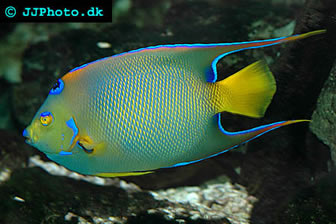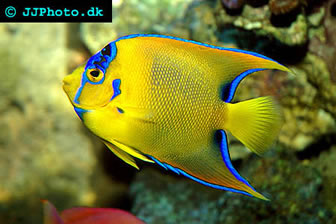Queen Angelfish
Holacanthus ciliaris

Adult

Juvenile - Copyright www.jjphoto.dk
The fish species Holacanthus ciliaris is known under several different English names, such as Queen angelfish, Queen angel, Blue angelfish, Golden angelfish, and Yellow angelfish.
In addition to being a popular aquarium fish, this species is also utilized as a food fish. Reports of ciguatera poisoning exist.
Holacanthus ciliaris has not been evaluated for the IUCN Red List of Threatened Species.
Geographical range, habitat and habits
The Queen angelfish lives in the Western Atlantic and Eastern Central Atlantic. In the Western Atlantic, it can be found from Florida, USA down to Brazil, including the Gulf of Mexico and the Caribbean Sea. In the Eastern Central Atlantic, it is found around Saint Peter and Saint Paul Islets, an archipelago located roughly 1,000 km from the city of Natal on Brazil's north-eastern coast.
The Queen angelfish inhabits coral reefs and lives alone or in pairs. The depth range for this species is 1-70 meters / 3-230 feet. It is especially fond of stony reef building corals like Acopora and is particularly common on reefs with prolific populations of Porifera sponges.
Size and appearance
The largest scientifically measured Queen Angelfish was 45.0 cm / 17.7 in.
The body is highly compressed with a blunt, rounded head. The body is shimmering blue and yellow and there is a large blue spot at the pectoral fin base. Large adults develop a purplish shade of blue and yellow-orange scale rims. The head is greenish yellow below the eyes and dark blue above.
The Queen angelfish (Holacanthus ciliaris) looks very similar to the closely related Holacanthus bermudensis, but the Queen angelfish has completely yellow tail, and a dark ringed spot on its forehead that looks almost like a crown. The ring that surrounds the spot is electric blue. As juveniles, the two species are very difficult to distinguish form each other.
The Queen angelfish can breed with Holacanthus bermudensis in the wild and the offspring will typically develop colour characteristics from both parents. The hybrid H. ciliaris x H. bermudensis is sometimes sold under the name Townsend angelfish. Some shops even claim that it is a true species by the name Holacanthus townsendi instead of a naturally occurring hybrid.
Queen angelfish care
This species is not recommended for novice marine aquarists because it is very sensitive to organic waste and it can be hard to get it to eat in the aquarium. The Queen angelfish is a very lively fish that will spend most of its time out in the open. It is active during the day and rests during the night.
A Queen angelfish will need an aquarium of at least 150 gallons / 575 litres. For a specimen that begins to approach the maximal length for this species, a 200 gallon / 750 litre aquarium is considered a minimum.
The aquarium where you keep your Queen angel should contain large enough hiding spots as well as ample swimming room. Coral skeletons are known to be appreciated. Include a lot of live rock and encourage natural algae growth.
The Queen angelfish can be semi-aggressive and it is therefore best to add it as the last fish to the aquarium. It is also important to provide the other fishes with suitable hiding spots to relieve stress. Keeping more than one fish from the genus Holacanthus can lead to a lot of violence, especially if you try to keep more than one male. If you want house Queen angelfish with other angels all specimens should be added simultaneously, but this is not a guarantee for a peaceful aquarium.
The Queen angelfish will love a prolific reef aquarium, but you should keep in mind that it can nip at soft corals, stony corals and clam mantles. It is actually fond of eating a long row of reef creatures (sponges, feather dusters, hydroids, tunicates, bryozoans etc) and keeping it in a reef environment will make anorexia and malnutrition much less likely. To save the aquarium from being seriously depleted by the angel it is however best to gradually train it to accept other types of food. You can read more about feeding in the feeding section of this article.
Keep the water temperature in the 72-78º F / 22-25.5º C, the pH-value between 8.1 and 8.4, and the specific gravity at 1.020-1.025. Do not get a Queen angelfish until you have a well established and stable aquarium. The amount of nitrate should not be allowed to rise above 10 ppm, and the levels of ammonia and nitrite should be kept at non-detectable levels.
Feeding Queen angelfish
In the wild, the Queen angelfish feeds chiefly on sponges, but it will also ingest a certain amount of algae, plankton, jellyfish, hydroids, tunicates and bryozoans. Young specimens remove skin parasites from larger fish and have a comparatively high degree of algae in their diet.
Getting a Queen angelfish to eat in the aquarium can be tricky since it is used to eating sponges. Providing it with enough sponges is cumbersome (or expensive) and most aquarists are therefore forced to train their queens to accept other types of food. Instead of serving sponges, you can give your fish fresh and frozen meaty foods, e.g. squid, shrimp, and opened shellfish, plus angelfish formula with sponge material. This fish also needs to be served algae on a daily basis, e.g. nori, spirulina, and fresh marine algae. Vegetables such as zucchini, aubergine and spinach are also appreciated.
Feed your Queen angelfish many small portions throughout the day instead of just one or two big meals.
Generally speaking, specimens smaller than 6 inches / 15 cm will be fairly interested in trying new foods, while larger fish can be hard to train onto anything else than live food and naturally occurring algae. If you encounter problems during feeding, subdue the light in the aquarium.
Once a Queen angelfish has acclimatized it to the aquarium and commenced feeding, it becomes very active fish and can even turn into a problem for less assertive fish by out-competing them during feeding time. It is bold and curious and can learn to eat out of your hand.
Breeding Queen angelfish
Little is known about the exact breeding habits of the Queen angelfish, but since it is frequently found in pairs in the ocean it is not unfeasible to assume that it is a monogamous pair breeder.
During the actual spawning, the male and female fish will place their bellies close to each other and release eggs and sperm. The batch is large, typically between 25,000 and 75,000 transparent eggs per spawning. During a spawning cycle, the female can release up to 10 million eggs.
The Queen angelfish is an egg-scattering species with buoyant eggs that will float around in the ocean until they hatch after 15-20 hours. The newly hatched larvae have not yet developed any fins, eyes or digestive system and will feed on their yolk sac for the coming 48 hours. When the yolk sac has been emptied, the offspring will have become developed enough to start eating plankton. Within a month, surviving fry will be around 15-20 mm / 0.6-0.8 in long. By this point they will seek out a part of the reef where there are finger sponges and coral and settle there. They will typically set up cleaning stations where they remove skin parasites from larger fish.
Marine Angelfish Articles:
African Flameback Angelfish – Centropyge acanthops
Asfur Angelfish – Pomacanthus asfur
Bicolor Angelfish – Centropyge bicolor
Blueface Angelfish – Pomacanthus xanthometopon
Cherub Angelfish – Centropyge argi
Coral Beauty – Centropyge bispinosa
Emperor Angelfish – Pomacanthus imperator
Flame Angelfish – Centropyge loricula
French Angelfish – Pomacanthus paru
Herald's Angelfish – Centropyge heraldi
Koran Angelfish – Pomacanthus semicirculatus
Lamarck's Angelfish – Genicanthus lamarack
Potter's Angelfish – Centropyge potteri
Regal Angelfish – Pygoplites diacanthus
Rock Beauty Angelfish – Holacanthus tricolor
Rusty Angelfish – Centropyge ferrugata
Watanabe's Angelfish – Genicanthus watanabei
